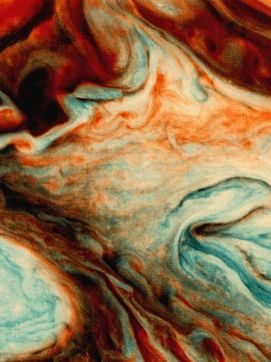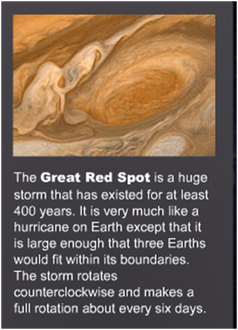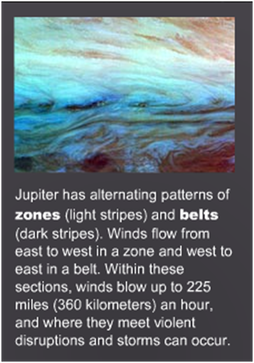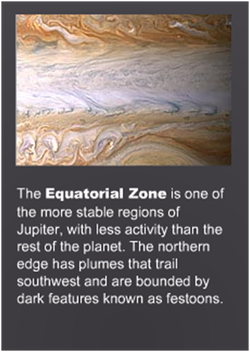Our Solar System
Jupiter's Surface

The visible surface of Jupiter is a deck of clouds of ammonia crystals, the tops of which occur at a level where the pressure is about half that at Earth's surface. The bulk of the atmosphere is made up of 89% molecular hydrogen (H2) and 11% helium (He). There are small amounts of gaseous ammonia (NH3), methane (CH4), water (H2O), ethane (C2H6), acetylene (C2H2), carbon monoxide (CO), hydrogen cyanide (HCN), and even more exotic compounds such as phosphine (PH3) and germane (GeH4). At levels below the deck of ammonia clouds, there are believed to be ammonium hydro-sulfide (NH4SH) clouds and water crystal (H2O) clouds, followed by clouds of liquid water.
The visible clouds of Jupiter are very colorful. The cause of these colors is not yet known. Contamination by various polymers of sulfur (S3, S4, S5, and S8), which are yellow, red, and brown, has been suggested as a possible cause of the riot of color; but, in fact, sulfur has not yet been detected spectroscopically, and there are many other candidates as the source of the coloring.
The interior of Jupiter is totally unlike that of Earth. Earth has a solid crust floating on a denser mantle that is fluid on top and solid beneath, Jupiter, on the other hand, may well be fluid throughout, although it could have a small solid core (say up to 15 times the mass of Earth!) of heavier elements such as iron and silicon extending out to perhaps 15% of its radius.
The bulk of Jupiter is fluid hydrogen in two forms or phases, liquid molecular hydrogen on top and liquid metallic hydrogen below; the latter phase exists where the pressure is high enough, say 3-4 million atmospheres. There could be a small layer of liquid helium below the hydrogen, separated out gravitationally, and there is clearly some helium mixed in with the hydrogen. The hydrogen is convecting heat (transporting heat by mass motion) from the interior, and that heat is easily detected by infrared measurements, since Jupiter radiates twice as much heat as it receives from the Sun.
The heat is generated largely by gravitational contraction and perhaps by gravitational separation of helium and other heavier elements from hydrogen, in other words, by the conversion of gravitational potential energy to thermal energy. The moving metallic hydrogen in the interior is believed to be the source of Jupiter's strong magnetic field.
The visible clouds of Jupiter are very colorful. The cause of these colors is not yet known. Contamination by various polymers of sulfur (S3, S4, S5, and S8), which are yellow, red, and brown, has been suggested as a possible cause of the riot of color; but, in fact, sulfur has not yet been detected spectroscopically, and there are many other candidates as the source of the coloring.
The interior of Jupiter is totally unlike that of Earth. Earth has a solid crust floating on a denser mantle that is fluid on top and solid beneath, Jupiter, on the other hand, may well be fluid throughout, although it could have a small solid core (say up to 15 times the mass of Earth!) of heavier elements such as iron and silicon extending out to perhaps 15% of its radius.
The bulk of Jupiter is fluid hydrogen in two forms or phases, liquid molecular hydrogen on top and liquid metallic hydrogen below; the latter phase exists where the pressure is high enough, say 3-4 million atmospheres. There could be a small layer of liquid helium below the hydrogen, separated out gravitationally, and there is clearly some helium mixed in with the hydrogen. The hydrogen is convecting heat (transporting heat by mass motion) from the interior, and that heat is easily detected by infrared measurements, since Jupiter radiates twice as much heat as it receives from the Sun.
The heat is generated largely by gravitational contraction and perhaps by gravitational separation of helium and other heavier elements from hydrogen, in other words, by the conversion of gravitational potential energy to thermal energy. The moving metallic hydrogen in the interior is believed to be the source of Jupiter's strong magnetic field.



